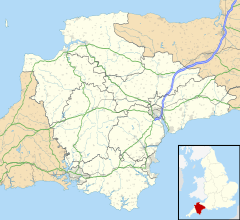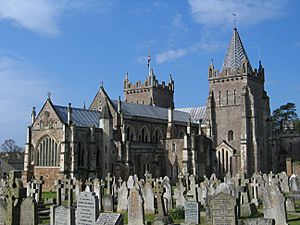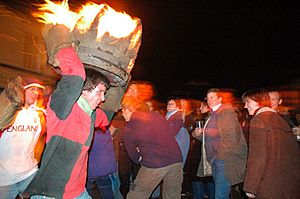Ottery St Mary facts for kids
Quick facts for kids Ottery St Mary |
|
|---|---|
 Paternoster Row |
|
| Population | 4,898 (2011) |
| OS grid reference | SY0995 |
| Civil parish |
|
| District |
|
| Shire county | |
| Region | |
| Country | England |
| Sovereign state | United Kingdom |
| Post town | OTTERY ST. MARY |
| Postcode district | EX11 |
| Dialling code | 01404 |
| Police | Devon and Cornwall |
| Fire | Devon and Somerset |
| Ambulance | South Western |
| EU Parliament | South West England |
| UK Parliament |
|
Ottery St Mary, known as "Ottery", is a town and civil parish in the East Devon district of Devon, England, on the River Otter, about 10 miles (16 km) east of Exeter on the B3174. At the 2001 census, the parish, which includes the villages of Metcombe, Fairmile, Alfington, Tipton St John, Wiggaton, and (until 2017) West Hill, had a population of 7,692. The population of the urban area alone at the 2011 census was 4,898.
There are two electoral wards in Ottery (Rural and Town). The total population of both wards, including the adjacent civil parish of Aylesbeare, at the 2011 census was 9,022.
The town as it now stands, has several independent shops, mainly in Mill Street, Silver Street and Yonder Street. An area known as 'The Square', is the heart of Ottery St Mary. There are pubs, restaurants, and coffee and tea rooms. Ottery provides services, employment, and a wide range of shopping for local residents and visitors from nearby villages and towns.
Contents
Church
The parish church of St Mary's has been referred to as "a miniature Exeter Cathedral". Like the cathedral it is cruciform in plan, with transepts formed by towers
Nikolaus Pevsner described the building as “lying large and low like a tired beast”. It is 163 feet long, and the towers are 71 feet high. It was consecrated in 1260, at which time the manor and patronage of the church belonged to Rouen Cathedral, as it had from before the Norman invasion. Pevsner assumed that the tower-transepts and the outer walls of the chancel date back to 1260, and that the towers were built in imitation of those at Exeter.
In 1335 John Grandisson, Bishop of Exeter, bought the manor and advowson from Rouen and two years later converted the church into a collegiate foundation with forty members. He rebuilt much of the church, and the present nave, chancel, aisles and Lady chapel date from this time. The nave is of five bays, and the chancel, unusually long in proportion, is of six, with vestry chapels to north and south.
The church is noted for its painted ceiling and early sixteenth-century fan vaulted aisle, the Dorset Aisle, designed and commissioned by Cecily Bonville, 7th Baroness Harington, whose first husband was Thomas Grey, 1st Marquess of Dorset.
The building was restored in 1850 by the architect William Butterfield. His alterations included lowering the floor level of the transepts, crossing and western part of the chancel to that of the nave, making the east end, designed for the needs of the collegiate foundation, more suitable for parochial use.
The south transept (bell tower) houses the Ottery St Mary Astronomical Clock, one of the oldest surviving mechanical clocks in the country. It is commonly attributed to Bishop John de Grandisson, who was Bishop of Exeter (1327–69) and adheres to Ptolemaic cosmology with the Earth at the centre of the solar system.
The church has ten misericords dating from the building of the church in 1350, five showing the arms of Bishop John de Grandisson. The church interior also has two medieval carved stone green men. There ia a small stone plaque commemorating the poet Samuel Taylor Coleridge in the south churchyard wall. Other interesting features include the tombs of Otho de Grandisson and his wife, the altar screen, sedilia, and a wooden eagle given by Bishop Grandisson.
Ottery St Mary parish registers are held in the Devon Record Office and begin in 1601.
Local traditions
Tar Barrels
The town typically stages annual events around Guy Fawkes Night when, in a tradition dating from the 17th century, barrels soaked in tar are set alight and carried aloft through parts of the town by residents.
The festivities begin in the early evening with children's, youths' and women's events, culminating in the men's event when a total of seventeen barrels are lit outside each of the four public houses in the town. (Originally there were 12 public houses in the town). The barrels, increasing in size up to 30 kg, are carried through the town centre, often packed with onlookers, in an exhilarating and risky spectacle. Only those born in the town, or who have lived there for most of their lives, may carry a barrel. Generations of the same family have been known to compete across the years and it is thought that the event may have originated as a means of warding off evil spirits, similar to other British fire festivals, around the time of Halloween. In recent years the event has been jeopardised by the need for increasing public liability insurance coverage. Nevertheless, the event continues and the town's population of 7,000 increases at the event to well over 10,000. During the event all roads in and out of Ottery St Mary are closed for safety reasons with diversions in place.
On 30 October 2008 the annual event was threatened by a severe hailstorm, which hit East Devon shortly after midnight, with the Fire Service describing the situation in the Ottery St Mary area as "absolute chaos". The storm led to serious flooding in the town, caused mainly by storm drains becoming clogged with hailstones. Roads became blocked and the Coastguard service was required to airlift some people to safety. The flooding also caused problems on the Millennium Green, where the annual bonfire and fairground were being constructed in preparation for the 5 November celebrations. One of the owners of the fairground said that the builders working there were "lucky to be alive". The clear-up operation was entirely successful, however, and both the carnival procession and the Tar Barrels and bonfire night celebrations went ahead as planned.
In 2009, the Factory Barrel was sabotaged by a visitor who threw an aerosol can into the barrel. The can exploded in the heat and 12 spectators required treatment for burns. In an unrelated incident, the roof of the old fire station burnt down on the night of the 2009 tar barrels.
Pixie Day
Pixie Day is an old tradition which takes place annually in June. The day commemorates a legend of pixies being banished from the town to local caves known as the 'Pixie's Parlour'.
The Pixie Day legend originates from the early days of Christianity, when a local bishop decided to build a church in Otteri (Ottery St. Mary), and commissioned a set of bells to come from Wales, and to be escorted by monks on their journey.
On hearing of this, the pixies were worried, as they knew that once the bells were installed it would be the death knell of their rule over the land. So they cast a spell over the monks to redirect them from the road to Otteri to the road leading them to the cliff's edge at Sidmouth. Just as the monks were about to fall over the cliff, one of the monks stubbed his toe on a rock and said "God bless my soul" and the spell was broken.
The bells were then brought to Otteri and installed. However, the pixies' spell was not completely broken; each year on a day in June the 'pixies' come out and capture the town's bell ringers and imprison them in Pixies' Parlour to be rescued by the Vicar of Ottery St. Mary. This legend is re-enacted each year by the Cub and Brownie groups of Ottery St. Mary, with a specially constructed Pixie's Parlour in the Town Square (the original Pixie's Parlour can be found along the banks of the River Otter).
Old Ottregians Society
An inhabitant of Ottery St Mary is known as an "Ottregian". One Sunday afternoon in 1898 six young men from Ottery St Mary, who were then living in London, met on the steps of St Paul's Cathedral, and resolved to form a Society to promote good fellowship among Ottery people wherever they may be. And so was founded the Old Ottregians Society, which took as its motto 'Floreat Ottregia ('May Ottery Flourish')" The Old Ottregians society still exists today (1997).
Old Ottery song
Another tradition in Ottery St Mary still continued today is the daily playing of the Old Ottery song. At eight-O-Clock, midday and four-O-Clock each day the Church of Ottery St Mary plays the Old Ottery song after the peal of the church bells. Tradition has it that the funerals of Old Ottregians always take place at 12.00 noon, with the funeral service commencing immediately following the playing of the Old Ottery song: The words are as follows ('kine' are cattle):
Sweet-breathing kine, / The old grey Church, / The curfew tolling slow, / The glory of the Western Sky, / The warm red earth below. // O! Ottery dear! O! Ottery fair! My heart goes out to thee, Thou art my home, wher'er I roam, The West! The West for me!
John Coke's ghost
Within St Mary's Church, a colourful effigy of a soldier named John Coke can be found in a niche. He is said to have been murdered by a younger brother in 1632, and therefore tradition avers that his spirit steps down from the alcove and wanders about the church interior.
Historic estates
Various historic estates exist within the parish of Ottery St Mary including:
- Cadhay
- Thorne
Sport and leisure
The Non-League football club, Ottery St Mary A.F.C. plays at Washbrook Meadows.
The Colin Tooze Sports Centre is located opposite the King's School and the Move Forward Gym is located in Finnimore Trading Estate.
From 1968 to 1974, Ottery had a folk club that met regularly every week in the town's London Inn with singers such as Cyril Tawney and other local artists appearing, as well a number of local singers. The club was listed in the EFDSS list of local rural folk clubs.
Transport
Until 1967 the town was served by Ottery St Mary railway station, which was closed under the Beeching Axe. The line ran from Sidmouth Junction on the main line from Exeter to Waterloo to the north of Ottery, and to Sidmouth and Exmouth to the south. The line split just south of Tipton St John, near the Bowd Inn. Both routes closed in March 1967. For many years the path of the railway, with the rails removed, remained in place, with evidence of the railway gates at places such as north of Cadhay Bridge.
Notable people
- Frederick Coleridge, cricketer and clergyman
- Samuel Taylor Coleridge, the Romantic poet, was born here on 21 October 1772. His father, the Reverend John Coleridge, was a vicar; the family lived at The Chanter's House when John Coleridge was headmaster of the King's School.
- Edward Davy (1806 – 1885), English physician, scientist, and inventor, born here
- Sir Ernest Satow, a diplomat, spent his retirement (1906–29) here at a house called Beaumont, which still stands. Sir Ernest was buried in the churchyard; there is a commemorative plaque to him in the church.
- Hugh Whitby, cricketer and schoolmaster
- Claire Wright, politician
- Stuart Hogg, Scottish rugby union captain resides in the town
See also
 In Spanish: Ottery St Mary para niños
In Spanish: Ottery St Mary para niños





